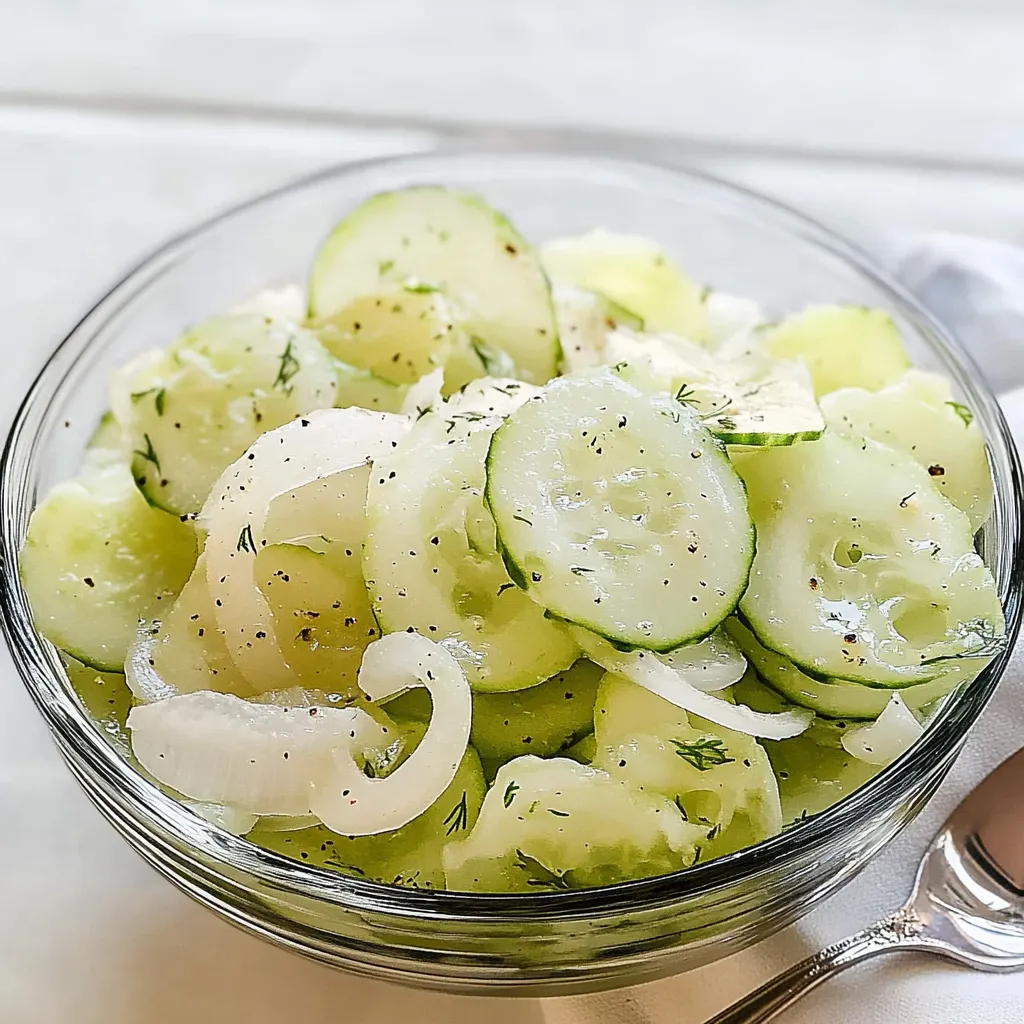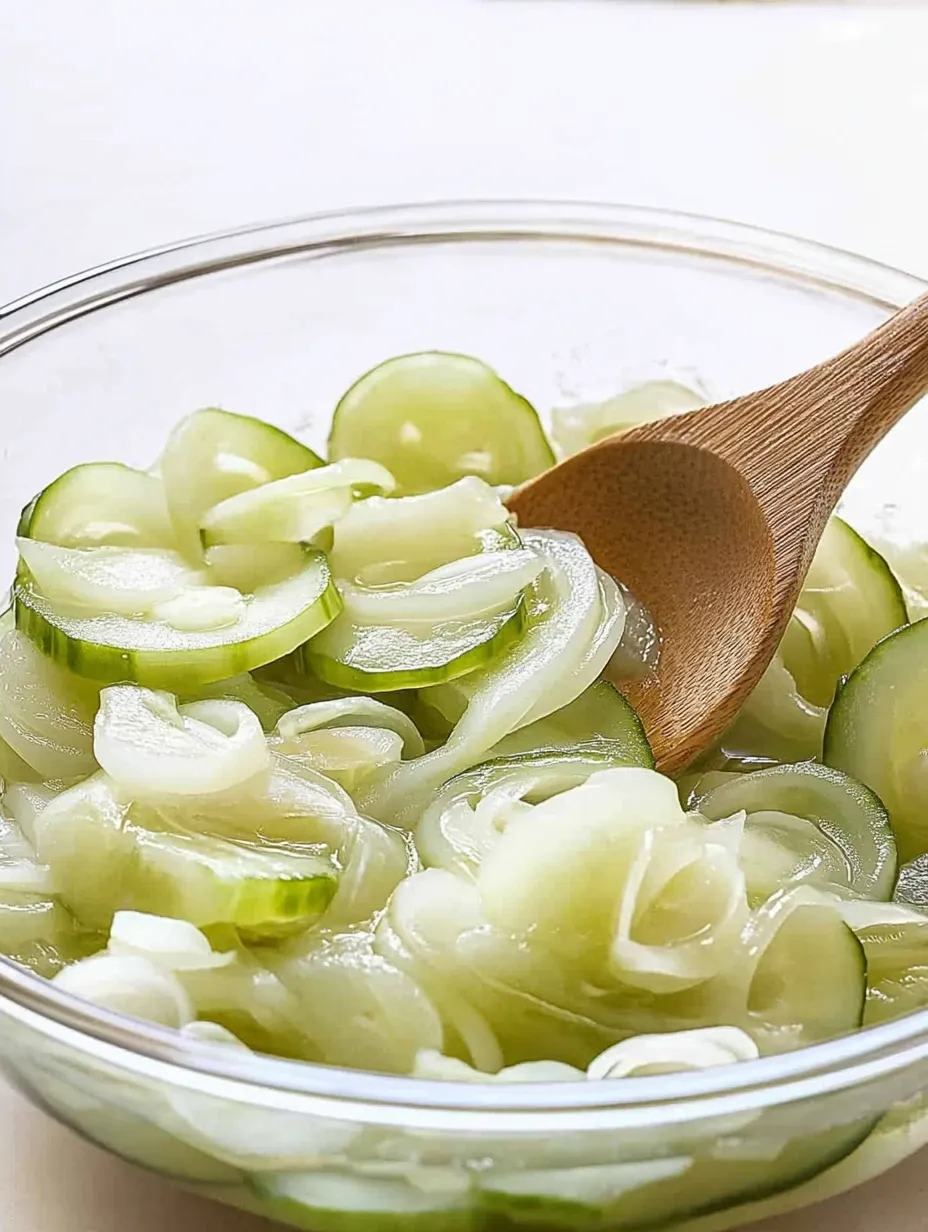 Pin it
Pin it
Heritage Cucumber Dish
This refreshing cucumber salad carries the essence of generations past, with a recipe carefully preserved from my Great Grandmother who brought it from her small German village. The magic lies in the unique preparation method that transforms humble cucumbers into something extraordinary through patience and tradition. I treasure this dish not only for its delicious flavor but also for the connection it provides to my family's culinary heritage.
Timeless Appeal
The first time I prepared this salad independently was for a family reunion where four generations gathered around our table. My grandmother watched carefully as I sliced the cucumbers, smiling with approval when I remembered to salt them properly as she had taught me. That afternoon, seeing relatives enjoy the same flavors that had graced our family tables for decades filled me with unexpected emotion. Now, whenever garden cucumbers reach their peak, this salad becomes a staple in my kitchen.
Simple Ingredients
- Garden Cucumbers (2-4 medium): Provide the refreshing foundation with their crisp texture and mild flavor that absorbs the dressing beautifully
- White Onion (1 large): Contributes essential aromatic sharpness that mellows during the salting process into sweet complexity
- Salt (3 tablespoons): Serves a crucial functional role beyond flavor, drawing out excess moisture to prevent watery salad while seasoning the vegetables
- Vinegar (2 teaspoons): Adds bright acidity that balances the richness of cream while enhancing the natural flavors of the vegetables
- Heavy Whipping Cream (1 cup): Creates the luxuriously silky dressing that coats each cucumber slice with velvety richness
- Fresh Dill (2 tablespoons): Provides the signature herbal note that transforms this from simple salad to authentic German specialty
 Pin it
Pin it
Traditional Method
- Proper Preparation:
- Begin with fresh, firm cucumbers preferably harvested that morning if using garden varieties. Wash thoroughly but do not peel unless the skin is particularly tough or bitter. Using a sharp knife or mandolin slicer, cut the cucumbers into very thin rounds approximately 1/8 inch thick. Consistent thickness ensures even salting and texture in the finished dish. Peel the white onion and slice it into paper thin rings or half moons depending on your preference. The thin slicing allows the onion to properly mellow during the salting process while still providing flavor throughout the salad. Place the sliced cucumbers and onions in a large colander set inside a bowl or over the sink.
- Essential Salting:
- Sprinkle the vegetables evenly with the full three tablespoons of salt, tossing gently with your hands to ensure complete coverage. This may seem like an excessive amount, but most will be rinsed away after drawing out the moisture. The salt serves two crucial purposes: it seasons the vegetables deeply while extracting excess water that would otherwise dilute the cream dressing. Allow the salted vegetables to rest for a minimum of two hours at room temperature, though my grandmother often left them for up to four hours for maximum moisture extraction. During this time, you'll notice significant liquid accumulating in the bowl beneath the colander, sometimes as much as a cup of cucumber water.
- Thorough Rinsing:
- Once the resting period is complete, rinse the cucumber and onion mixture thoroughly under cold running water, gently tossing with your fingers to ensure all excess salt is removed. This step is crucial for balanced flavor, as properly rinsed vegetables will retain just enough salt without overwhelming the palate. After rinsing, gently press the vegetables against the sides of the colander to remove as much water as possible without crushing them. For extra moisture removal, spread the vegetables on a clean kitchen towel and pat gently with another towel. Transfer the well drained cucumber and onion mixture to a serving bowl large enough to allow for easy tossing with the dressing.
- Finishing Touch:
- Pour the heavy whipping cream over the prepared vegetables, allowing it to settle into all the spaces between slices. Add the vinegar, drizzling it evenly across the surface rather than pouring in one spot. Sprinkle the freshly chopped dill throughout, reserving a small amount for garnish if desired. Using a large spoon or rubber spatula, gently fold all ingredients together with a lifting motion rather than stirring, which helps maintain the structural integrity of the cucumber slices. The cream will immediately begin to cling to the cucumber surfaces, creating a consistent coating rather than pooling at the bottom. Taste a small portion and adjust vinegar or add a tiny pinch of additional salt if needed. The salad can be served immediately or covered and refrigerated for up to 24 hours, during which time the flavors will continue to develop and meld beautifully.
I particularly treasure the memories associated with this recipe. My great grandmother always prepared this salad in a specific blue ceramic bowl that eventually passed to my mother. Watching her hands work the cucumbers, weathered from years of gardening and cooking, connected me to generations of family cooks who prepared this same dish. When I left for college, a handwritten recipe card for this salad was tucked into my belongings, becoming one of my first successful dishes shared with roommates. Now my own children help prepare it, learning the patient process of salting and waiting that produces such remarkable results from ordinary ingredients.
Perfect Accompaniments
This versatile salad pairs beautifully with numerous main dishes while offering refreshing contrast to heavier German fare. Serve alongside hearty schnitzel, allowing the cool creaminess to balance the richness of the fried cutlet. When grilling during summer months, this salad provides the perfect counterpoint to smoky bratwurst or other grilled sausages. For traditional German meals, include it with sauerbraten and spätzle for an authentic combination that honors its heritage. The subtle flavors also complement simple roasted chicken or pork tenderloin without competing for attention. During hot weather, consider serving larger portions as a light main dish alongside dark bread and quality butter for a satisfying yet refreshing meal that requires no cooking.
Regional Variations
This foundation recipe welcomes adaptations based on family traditions or regional German influences. Southern German versions often incorporate thinly sliced radishes for peppery crunch and visual appeal with their bright red edges. Some families substitute sour cream for the heavy cream, creating tangier flavor that pairs particularly well with fatty meats. Northern German variations might include a small amount of sugar in the dressing to create sweet sour balance reminiscent of other Scandinavian cucumber preparations. My maternal grandmother occasionally added thinly sliced apples for subtle sweetness, while my paternal side preferred the purity of cucumbers alone. Those seeking heartier versions might incorporate boiled potato slices, transforming the dish into something closer to potato salad while maintaining the distinctive cucumber flavor profile.
Storage Wisdom
This salad maintains remarkable quality when properly stored, though its texture gradually softens over time. Transfer any unused portion to a glass container with a tight fitting lid rather than plastic, which can impart flavors to the delicate cream dressing. Before refrigerating, place a paper towel over the surface to absorb any additional liquid that might separate during storage. The salad remains delicious for up to three days when properly refrigerated, though the cucumbers will continue softening and releasing additional moisture. Some family members actually prefer the texture after overnight refrigeration, when the flavors have fully melded. When serving leftover portions, drain any accumulated liquid and refresh with a small handful of newly sliced cucumber and additional fresh dill if available. The salad does not freeze well due to the cream base and the delicate nature of the cucumbers.
 Pin it
Pin it
After preparing this salad countless times through the seasons of my life, I've come to appreciate it as more than just a recipe but rather as a tangible connection to my heritage. What begins as simple ingredients transforms through traditional methods into something greater than the sum of its parts. The patience required for proper salting teaches lessons about cooking that extend far beyond this single dish. While modern recipes often prioritize speed and instant gratification, this salad reminds us that some culinary traditions are worth preserving exactly as they've been practiced for generations. The satisfied smiles around my table when I serve this dish echo those from family gatherings decades past, creating a beautiful continuity of flavor and memory across time.
Frequently Asked Questions
- → Why do you salt the cucumbers and let them sit for so long?
- Salting the cucumbers and letting them sit for 2 hours draws out excess moisture, which prevents the salad from becoming watery. This process, called 'degorging,' also seasons the cucumbers throughout and helps them maintain their crispness even after being dressed. The salt breaks down some of the cucumber's cell walls, allowing them to better absorb the flavors of the dressing.
- → Can I use sour cream instead of heavy cream?
- Yes, absolutely! The recipe mentions that you can use either heavy whipping cream or sour cream. Sour cream will give you a thicker, tangier dressing that's more common in many German households. Heavy cream creates a lighter, more delicate dressing. Both are authentic variations of German cucumber salad, so it's really about your personal preference.
- → How far in advance can I make this German Cucumber Salad?
- You can make this salad up to 24 hours in advance. The flavors actually improve as they meld in the refrigerator. However, if you're preparing it more than a few hours ahead, you might want to add a bit more dressing just before serving, as the cucumbers may release more liquid over time. The salad is at its best within the first day of making it.
- → What kind of vinegar works best for this recipe?
- The recipe calls for vinegar without specifying the type, which gives you flexibility. White vinegar works well for a clean, sharp tang. White wine vinegar or apple cider vinegar add subtle fruity notes. Traditional German recipes might use wine vinegar. Avoid balsamic or other dark vinegars as they will discolor the creamy dressing.
- → Can I reduce the amount of salt in this recipe?
- The 3 tablespoons of salt specified in the recipe is for the salting/degorging process, not for the final dish. Most of this salt gets rinsed away after the cucumber has released its moisture. If you're concerned about sodium, you can reduce the salt somewhat, but you'll need enough to properly draw out the cucumber's moisture. Be sure to rinse thoroughly after the resting period, and taste test as the recipe suggests - you can always rinse again if needed.
- → What main dishes pair well with German Cucumber Salad?
- This refreshing cucumber salad pairs beautifully with traditional German dishes like schnitzel, bratwurst, or sauerbraten. It's also excellent alongside grilled meats, especially pork and chicken, as the cool creaminess balances the richness and char. For summer meals, serve it with burgers, grilled fish, or as part of a picnic spread. The salad's light, refreshing nature makes it a perfect counterpoint to heavier, more substantial main courses.
